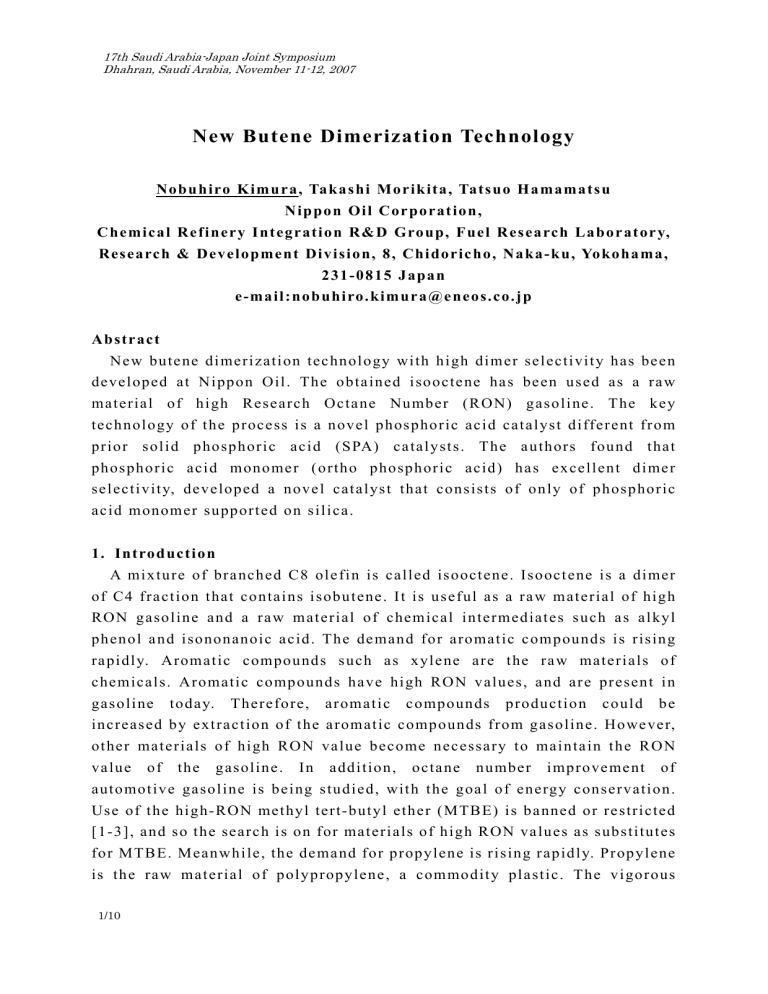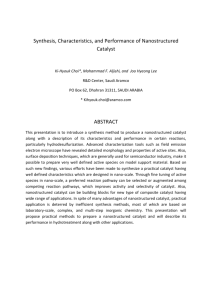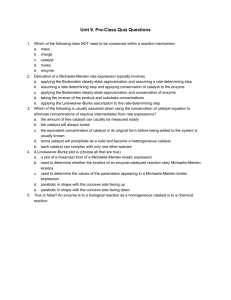New Butene Dimerization Technology
advertisement

17th Saudi Arabia-Japan Joint Symposium Dhahran, Saudi Arabia, November 11-12, 2007 New Butene Dimerization Technology Nobuhiro Kimura , Takashi Morikita, Tatsuo H amamatsu Nippon Oil Corporation, Chemic al Refinery Integrati on R& D Group, Fuel Research Laboratory, Research & Development Di vision, 8, Chidoric ho, Naka- ku, Yokoham a, 231- 0815 Japan e-mail: nobuhi ro .kimura @e neos. co .jp Abstract Ne w bute ne di me ri zation tec hnol ogy with hi gh di mer se l ectivit y has be en devel oped at Ni ppon Oil . The obta ine d isoocte ne ha s be en us ed a s a ra w mat erial of hi gh Res earc h Octa ne Number (RON) gasoline. The key technology of the process i s a novel phos phoric aci d catalyst different fr om prior sol id phosphoric aci d ( SPA) catal yst s. The a uthors found that phosphori c aci d monome r ( ortho phosphori c acid) ha s excelle nt di mer selecti vity, developed a nove l cata lyst that consists of only of phosphoric acid monomer s upported on sil ica. 1. Int ro d uct i on A mi xtur e of bra nched C8 ol e fi n is call ed isooctene. Isooct ene i s a di mer of C4 fra c tion that c ontai ns is obut ene . I t is us e ful as a ra w mat erial of hi gh RON gasoline and a ra w mat erial of chemical i ntermediates such as alkyl phe nol a n d isonona noic a cid. The de mand for aromatic compounds i s rising rapidl y. Aroma tic compounds s uc h as x yl e ne are t he ra w mat erials o f chemicals. Ar omati c compounds have high RON value s, a nd ar e pr esent i n gasoline today. Therefore, ar omati c c ompounds producti on coul d be increased by extr act ion of the aromatic compounds fro m ga solin e. Ho we ver, other mat erials of high RON value become n ec essar y t o mai nt ai n t he R O N value of the gasoline . In addition, octa ne number i mpr ove me nt of automotive gasoline is being studi ed, with t he goal of energy conservation. Use of t he hi gh- RON methyl tert-but yl ether (M TBE) i s ba nne d or re stricted [1-3], and so the search is on for materials of high RON values as substitutes for M TBE. Mea n whi le, the de ma nd for propyle ne is ri sing r apidl y. Pr opyl ene is the raw mat erial of pol ypropylene , a commodit y pl as tic. The vigorous 1/10 17th Saudi Arabia-Japan Joint Symposium Dhahran, Saudi Arabia, November 11-12, 2007 de mand has led t o increa sed propyle ne producti on. ABB Lummus Global’s OCT ( Ole fi n Conve rsion Te c hnol ogy), a pr oces s which pr oduces pr opyl ene fr om n-butene and ethylene , has bee n installe d in var i ous pla ce s. Thi s technology was also adopted by Nippon Oil Corporation. OCT is a technology that manufactur es pr op yl ene by t he metat hesis rea ction of n-butene and ethylene. Isobutene from the C4 fr action is unneces sa ry i n t he metathesis reaction. On the other hand, the manufacturing process of poly mer gasoline by oli gomeri zation of light ol efin has been researched since the past . Concerni ng the di me riz ation pr oc ess usi ng FCC-C4 f eedst oc k, whi ch is rich i n n- butene, t h ere ar e some examples of commercialization such as UOP's I n Al k process [7-13] and the NExOCTANE proc ess develope d by Neste Oil and Kell ogg Brown & Root [14-16]. However, there ar e no examples of selective di merization using solid acid catalysts with high conc entr a tion of is obut ene , whi ch has high rea c tivity. To use t he i s obut ene in t he C4 fracti on effecti vel y, we de veloped new is obut ene di me r ization technology. Pr oduc t is ooct e ne bec omes a ra w materi al for hi gh RON gasoline. A commercial pl ant has been onstre a m sinc e 2006 in Kawa saki Japa n ( Fi g. 1), a nd producti on of is ooc tene is 40,000 t ons per year. Fig. 1 2/10 Commercia l pla nt 17th Saudi Arabia-Japan Joint Symposium Dhahran, Saudi Arabia, November 11-12, 2007 2. Tec hnology Sum mary 2-1. Cat a lyst The key t echnology of t he pr oces s i s a novel phosphoric ac id catal ys t tha t differs from prior SPA catalysts. The outline of the developed catalyst is as follows. 2-1-1. Dimer Selectivity The re acti vity of i s obut ene i s higher t han n-but ene, a nd oligomeri zation of isobut e ne oc cur s easily usi ng a n aci d catalyst. Its use i n di mer pr oducti on was me nti one d a bove. On the ot her hand, it is no t use d for pr oduction of heavy pr oduct s l arg er t han tri mer s at pr esent . Therefore, the development o f catalysts with hi gh di me r selectivity is of utmost i mpor tance. However, oligomeri zation of butenes is a consecutive reaction, so it is diff icult to obtai n t he di mer only. Al s o, di mer selecti vi ty decrea ses a s is obut ene conversi on i ncre as es. Fig. 2 s hows t he re lation be twee n is obut ene conversion and dimer selectivity in the reaction of isobutene using silica alumina and the developed catalyst. With solid acids such as t he sili ca alumina catalyst , as isobutene conversi on r ose , di mer selec tivity dec rease d. On t he ot her ha nd, the de ve lope d cat alyst s howe d hi gh di mer se lectivit y even at higher conver sion rates. Di mer yi eld is obt ai ned as is obut ene conversion multiplied by dimer selectivity. Di mer yiel d can be r aised by 20% or more wit h t he de veloped cat alyst compared with th at with the silica alumina catalyst. The re sult ca n be explained by t he difference i n reaction me cha nis m. The reaction progresses by cation reaction mechanism and passes the alkyl cation with the silica alumi na catalyst. Reactivity of the alkyl cation does not change, regar dless of the carbon number. Ther efore, di me r easily poly merizes, and the di mer selectivit y decreases. On t he ot her hand, with the phosphori c ac id c atalyst t he reaction progresses by t he ester reactio n me cha nis m. Is obut ene react s wit h phosphori c acid, pr oduci ng phosphori c acid est er (Fig. 3) . Since the re is thr ee-di me nsi ona l restr icti on in phos phor ic acid ester, it is thought that bulk high polymers are difficul t to form. It was found that the esterification reaction th at ha s hi gh di me r s electivit y occurs most re a dily whe n the phosphori c acid i n t he cat alyst is a monomer. Conventi onal SPA c atalyst s c ontai n sil icon phos phate a nd phos phor ic aci d poly mer [4-6]. Sili con phos phate i s a compound of phosphoric aci d bonde d 3/10 17th Saudi Arabia-Japan Joint Symposium Dhahran, Saudi Arabia, November 11-12, 2007 with silica, and the phosphoric acid polymer is a compound that is condensed by dehydration of phosphoric acid monomer. This is because the catalyst is ma nufactured at a p proxi mate ly 300 de grees . There fore , it was not easy to take an ester react ion me chanis m tha t ha d high di me r selecti vity. The devel oped catal yst a chieves hi gh acti vit y a nd hi gh di mer s el ectivit y, because it consist s onl y of phosphor ic acid monome r s upporte d on sili ca. In ot her wor ds , we de vel oped a novel cat alys t that is different fr om prior SPA catalysts. Dimer selectivity, % 100 High-yield >Δ20% Developed catalyst Sillica alumina catalyst Isobutene conversion, % Fig. 2 4/10 Perfor ma nc e of de vel ope d c atal yst 100 17th Saudi Arabia-Japan Joint Symposium Dhahran, Saudi Arabia, November 11-12, 2007 O + HO P OH HO isobutene phosphoric acid HO P P OH buthyl phosphate O O O O OH + OH O HO P OH OH isobutene dimer O HO P Fig. 3 O OH steric hindrance isobutene trimer Ester intermediate reaction mechanism 2-1- 2. Catalyst life Fact ors t hat decr ease the acti vity of the developed catalyst are both the out fl ow of phos phoric aci d a nd t he c ha nge i n phosphori c a cid st ates fr om th e dehydra ti on-c ondensation of phosphori c aci d. Outflow of phosphoric acid Conventional SPA catalyst consists of silicon phosphate, which is phosphoric acid chemically bonded to silica. On the other hand, the developed catalyst consists of only phosphoric acid monomer supported on silica. There i s no chemical bonding between the phosphoric acid and support . This fa ct is confir me d by X-ra y di ffra ction. Wh en there is no bonding, it is not able t o obtain t he crystall ine pea k. Thus , the develope d catalyst had a demerit in that the out fl ow of t he phosphoric aci d on t he catalyst i s more than t he c onve ntiona l catal yst. As a result of our deeper knowl edge re gardi ng the outfl ow of pho sphori c aci d, we lear ned that the out fl ow of phos phoric a ci d can be controlled to levels typical with conventi onal t echnology through opti mi zation of the ope rat ional met hod. De hy drati on conde nsation of phos phor ic ac id 5/10 17th Saudi Arabia-Japan Joint Symposium Dhahran, Saudi Arabia, November 11-12, 2007 Wit h moi sture , phosphoric a cid on the catal yst changes phosphori c aci d states. When moist ure densit y is l ow, phosphor ic acid is conde nse d fro m phosphori c aci d monomer to a phos phoric aci d poly mer by de hydrati on. The change of phosphoric acid states can be deter mined by the P 3 1 -MAS NMR of the catal yst ( Fig. 4). The chemi cal shift of phosphoric a cid monomer i s 0 ppm, and phosphoric acid polymer is below -20 pp m. When water of t he necessary quantity is not added, it becomes a lower activity catalyst. Our exami nati ons showed t hat when phosphori c acid st ates cha nge from monomer to polymer, both activity and selecti vit y dec reas e. The phosphori c acid state of the developed catalyst is phosphoric acid monomer. In order to contr ol t h e de hydra tion condensati on of t he phos phor ic a ci d on t he c atalyst , the nece ss ary qua nti ty of wate r is added to the C4 feedstock in this process. Low active catalyst Fresh catalyst 80 60 Fig. 4 40 20 0 -20 -40 -60 -80 ppm P 3 1 MAS NMR spectr a of cat al ysts By controlling t he activit y decrease by the above-mentio ned method, th e devel op ed cat alyst mai nt ai ne d t he t a rget yield for six mo nths or more (Fi g. 5). The re actor te mperat ure r ose s ever al de grees duri ng si x months , and it s activit y hardly decr eased. There fore , a long cat al yst li fe c a n be e xpe cted. 6/10 Yield of isooctenes, % 17th Saudi Arabia-Japan Joint Symposium Dhahran, Saudi Arabia, November 11-12, 2007 Target 0 50 Fig. 5 100 Days on feeds 150 200 Life of develope d cat alyst 2-1- 3. Re generat ion It is i mpossi ble to regenerat e conventional SPA catalysts when activity decreases. This i s because they consist of phosphori c a cid c he micall y bonded to the silica support. On the other hand, the developed catalyst has an advant age i n t hat the catal yst can be easil y r egenerate d by s oaking i n a phosphori c a cid s ol ution i n a reactor. Th is is because the developed catalyst is a simple catalyst that is phosphoric acid monomer adsorbed on silica. It is thus possible to greatly reduce the amount of waste ca talyst . Al so, the per for ma nce of t he catalyst a fter re- soaking i s e qual to be fore. 2-2. Proc ess Wit h t hi s t echn ology, the high dimer selectivity of the developed catalyst allowed us to achieve a more si mpl e pr oces s. 2-2- 1. Reactor Sinc e ol i gomeri zat ion of butene s is a consecutiv e reaction, di mer selecti vit y i ncreases as but ene conv ersion is lowered in mild reaction conditions. Wit h a low select i vity catalyst, butene convers ion i s kept low in the first 7/10 17th Saudi Arabia-Japan Joint Symposium Dhahran, Saudi Arabia, November 11-12, 2007 reactor in order to obtai n hi gh di mer selectivit y. Unreact e d butenes are then separ ated by distillation, and i t is necessary to repeat t he same met hod i n t he second r eactor. High di mer yiel d can be achieved t his way, but it necessitates a large investment in equipment . I n contrast , we can achieve high di me r yiel d i n a single- s tep re acti on wit h t he de vel oped c atalys t tha nks to i ts hi gh di mer selecti vity. There i s t hus one re actor invol ve d in t he proc ess , whi ch tra nslate s t o lower i nvest ment c osts . 2-2- 2. Quench Di meri zat ion of butenes i s an exot he r mic reac tion. Wit h convent ional technology, the reaction heat is removed using the unreacted raffi n ate. This is t he way that t he unreact ed r a ffinate separat ed from effl uents of the reactor by distillation feeds to the catalyst beds. Therefore, reaction heat in the upper bed is removed. With this technology it is di fficult to for m heav y product s large r tha n tri mers beca use the rea cti on progre sses by t he est er reaction mechanism. Therefore, it is pos sible t o re move the re acti on heat by the fact that the reactor effl uent which is not distilled is circulated back t o the react or top. There is no decreas e of dimer selectivity because it is di fficult for di mers to form heavi er pr oducts. There fore, it was possible to use an inexpensive adiabatic reactor. Thus, as shown in Fi g. 4, thi s process becomes a si mple one invol ving one adiabatic reactor and t wo di stillation towers. 8/10 17th Saudi Arabia-Japan Joint Symposium Dhahran, Saudi Arabia, November 11-12, 2007 Isobutene fraction Butane Isooctene Dimerization reactor Butane stripper Heavy oil fraction Product stripper Fig. 6 Develope d di merizati on proces s 2-3. Product char acteristi cs Pr oduct isooctene, whi ch is the dime r of isobutene , is the isomer of C8 ole fin. The ma in product s of is ooct ene are 2,4,4-tri me thyl pent e ne-1 and 2,4,4-t ri methyl pent ene- 2. These are c a lled diis obute ne. I s oocte ne is use ful as a raw mat erial for high RON gasoli ne. Me anwhil e, dii sobutene is use ful as a c he mic al i nt er mediat e for al kyl phenol, isonona noic aci d a nd ot her product s. The Bl ending Rese arch Oct a ne Number (BRON) of isooct ene is 115, whi c h is hi gh. There for e, it can contri but e to ene rgy c ons ervation by improving the fuel consumption of gasoline automobiles. In addition, the RON and distillation characteristics of isooctene rival those of aromatic compounds s uc h as t olue ne, meaning it is possible to substitute isooctane for aromatic compounds i n gasoline. In other words, it bec ome s possi ble to increase producti on of aromatic co mpounds i ndirectly. Though phosphori c acid catal yst i s use d, t her e is no phosphorus i n t he fi nal product. 3. Conclusion We found that phosphoric acid monomer has excellent dimer selectivity, and developed a novel cat alyst that consists only of phosphoric acid monome r s upporte d on sili ca. Because the devel oped cat alyst can be rege nerat ed, waste catalyst c an be re duced. BRON of isooctene i s 115, and it 9/10 17th Saudi Arabia-Japan Joint Symposium Dhahran, Saudi Arabia, November 11-12, 2007 can cont ribute to the energy conservati on thr ough fuel economy improvement for gasoline automobiles. In addition, the RON and distillation chara cteri stics of i sooc tene rival t hos e of ar omatic comp ounds . Is oocte ne can be used to repl ace ar omatic compounds in gasoli ne. I n ot her words, it become s pos sible t o increa se pr oducti on of aromati c c ompounds indire ctly. A c ommer cial pla nt has bee n onstr ea m since 2006, with annual production of 40,000 t o ns. 4. Refe re nces [1] Executive order D- 5-99 by the Governor of t he Stat e of Cali for nia, Mar 25, 1999. [2] Exe cutive order D- 52- 02 by t he Governor of the Sta te of Cali for nia, Mar 15, 2002. [3 ] M . L. Honk ela, A. O.I . Kra us e, Catalysis Letters., 87 ( 2003) 113. [4] R.F.Ja me son, J.Chem.Soc.(1959) 752-759. [5] E.H.Brown, C.D.Whitt , I n d.Eng.Che m. 44 ( 3) (1952) 615-618. [6] J.Villadsen, H.Livbjerg, Catal. Rev-Sci.Eng. 17 (1978), 203. [7] L.Cha rles, M.Ji ll, K.Ste v en, NPRA 2001 Annual Meet ing, Ne w Orle ans , LA, 18-20, Ma rch 2001, AM- 01-24. [8] K. We issermel and H.-J.Arpe, Industri al Organi c Che misst ry, Verlag Che mie, We inhei m, 1978, p.75, 172, 176. [9] G.Egl off and R.F.Davis, XII Int ernational Congress of Pure and Applied Chemistry , Ne w Yor k, Se pte mber 10- 13, 1951. [10] W. O.Haag, Chemic al Enginee ring Progress Sy mposi um Serie s, No.73, Vol.63. [11] F. Cavani, G.Girotti, G.Te rzoni, Appl. Catal., A Gen. 97 ( 1993) 177- 19 6. [12] S.R.Bet hea , J .H.Karchmer, Ind. Eng. Chem. 48 (3) ( 1 956) 370- 377. [13] T. R.Kr awietz, P.Lin, K.E. Lotterhos, R.D.Torres, D.H.Barich, A.Cl ear fi eld, J.F.Haw, J. Am. Chem. Soc. 120 ( 33) (1998) 8502- 8511. [14] PEP Re vie w 2003- 12 : [15] H.D.Ploa n, R.Birkho ff, M.F. Gilbert, M.Nurminen and A. Pyhalahti, NRPA 2000 Annual M eeti ng, Sa n Ant oni o, TX, 26-28, M ar ch 2000, AM- 00- 34. [16] P. Hunszi nger, H.Jarvelin, V-M .Purola, M.Nurminen, M.S.Khali l, and R.Bir khoff, NRPA 2003 Annual Meeti ng, San Antonio, TX, 23-25, Marc h 2003, AM -03- 43 10/10








